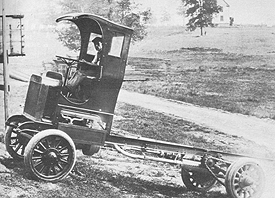Thomas M. Strah
| Managing EditorThe Century of Trucking
At the close of the 19th century, technological marvels were already propelling an optimistic America into the future at a rapid pace. Telegraphy, telephones, electricity and the internal combustion engine were established realities of civilized life, and the wonders of the unfettered airways – radio and aviation – were only a few years distant. Yet the 1800s are remembered as the age of iron and steam, the century when the railroad was king.
Today, looking back from our millennial perch, what can we say about the 20th century? What sort of age was it? As the residues of wars, great and small, testify, it was an era of nearly unparalleled savagery. Yet remarkable social-political achievements were won despite overwhelming odds, and science, medicine and technology advanced on a dizzying, upward curve.
For the full story, see the Jan. 10 print edition of Transport Topics. Subscribe today.
 |  Motor Vehicle Manufacturers Association |
 | As with automobiles, trucking technology was in its infancy early in the 20th century, as evidenced by this 1908 General Motors cabover with rear chain drive and solid rubber tires. |
It was the American Century, as we Americans like to say. It was also, arguably, the century of trucking.
Consider the rise of our industry. To start with, as the last century opened, the only sign of what was to come was the tentative marriage of the earliest gasoline engines with small, crude cargo frames. On the breadth of the continent there were only 10 miles of concrete pavement worthy of the name “highway.” Roads at best were sporadic, muddy horse tracks. Freight chugged from farm and factory to the city on shining rails, while infant trucking confined itself to local delivery.

